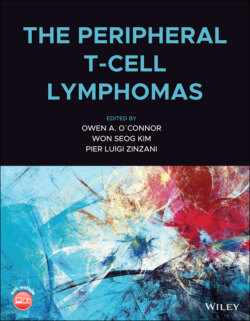Читать книгу The Peripheral T-Cell Lymphomas - Группа авторов - Страница 79
Viral and Chimeric Models
ОглавлениеChimeric models have been created by transplanting bone marrow cells transduced with a retroviral vector carrying NPM1‐ALK cDNA into lethally‐irradiated mice. The first model was reported by Kuefer et al., who infected 5‐fluorouracil‐treated murine bone marrow cells with NPM1‐ALK cDNA using retrovirus and then injected them into lethally irradiated BALB/cByJ mice [20]. Transplanted mice developed B‐lineage large cell lymphomas at four to six months in mesenteric lymph nodes, with metastases clearly associated with aberrant ALK activation [20]. Miething et al. later asked whether B‐cell phenotypes seen in the Kuefer at al. study were attributable to low infection efficiencies and hence low NPM1‐ALK expression. To address this possibility, they compared infection conditions employing low versus high multiplicity of infection and confirmed that lower multiplicity of infection promoted plasmacytomas around 12–16 weeks in mice, while higher multiplicity of infection caused aggressive histiocytic malignancies around 3–4 weeks [21]. Miething et al. also developed a murine model of ALCL by employing a Lox‐STOP‐Lox‐NPM1‐ALK encoding vector [22]. They then infected bone marrow cells from two sets of mice: one expressing Cre controlled by the lysozyme M‐promotor (lysM‐mice), which is active in the myeloid compartment and the other expressing Cre from the granzyme B‐promotor (GrzmB‐mice), which is mainly active in T cells. Mice transplanted with bone marrow cells from lysM‐mice developed histiocytic malignancies around four to six weeks, while those from GrzmB‐mice developed a mixed T‐cell lymphoma/histiocytic malignancy around four to six weeks [22]. Although these models do not precisely mimic human ALCL in humans, they provide versatile tools to examine NPM1‐ALK signaling pathways in vivo.
